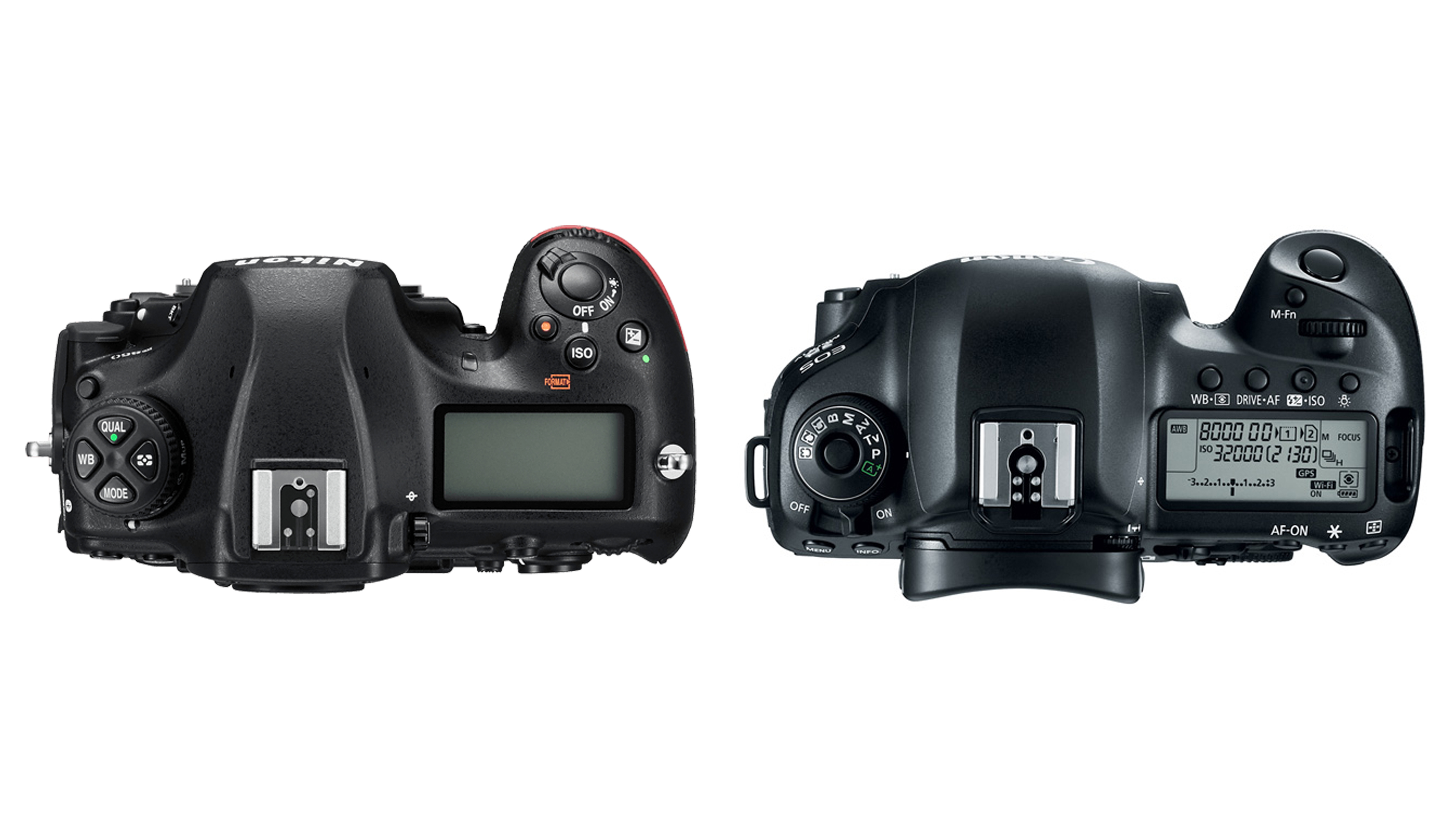

The Nikon D850 and the Canon EOS 5D Mark IV aren’t exactly in direct competition with each other. While both are two full-frame DSLR cameras that target advanced and pro photographers, there’s a number of differences between them both in design and in their specs.
A sensor with a higher resolution and back-illumination, as well as wider boosted sensitivity range and considerably more AF points, give the Nikon D850 a great advantage in specs. It also has the upper hand when it comes to design. Considering the two cameras launched around the same price point and are now both under $3,000, these superiorities are further proof of the incredible job Nikon has done with the D850.

Still, to give Canon’s contender its due, it’s a capable DSLR in its own right. And, their specs show that these two cameras aren’t meant for the same use cases. The D850 is meant for low light, wildlife, and landscape photographers who need all the firepower they need. Meanwhile, the 5D MIV is more for shooters with no particular focus and shoots a wide range of subjects.
On paper, the Nikon D850 may have a clear advantage, but that doesn’t mean that it’s the ultimate winner for most DSLR photographers.
Nikon D850 vs Canon EOS 5D Mark IV: Price
The Nikon D850 launched in August 2017 at a whopping £3,499/$3,299/AU$5,399, putting it in the prosumer to pro market. Bizarrely enough, the Canon EOS 5D Mark IV, which launched a year prior in August 2016, was introduced at a slightly higher £3,599/$3,499/AU$5699.
The good news is that both cameras have now dropped their respective price tags. These days, the D850 is retailing a few hundred dollars less at around £2,699/$2,999/AU$4,899.
On the other hand, the 5D MIV is even cheaper in the US and Australia at $2,499 and AU$3,999 respectively. In the UK, it has dropped its price as well though it is still a bit more expensive than the D850 at £2,799
Get all the latest news, reviews, deals and buying guides on gorgeous tech, home and active products from the T3 experts
The prices of both bodies certainly play a massive role here. Three years ago, the D850 would have been the obvious choice considering it came with a cheaper alongside better features. Now that the 5D MIV is slightly cheaper in some regions, that might just be enough to convince some consumers, especially folks who prefer to save and photographers who are already invested in the Canon system.
Nikon D850 vs Canon EOS 5D Mark IV: Design and Features
For most people looking for a new DSLR regardless of the system or the price, however, the Nikon D850 remains a compelling choice in terms of features and specs. Even in design, it has a few wins over the Canon EOS 5D Mark IV.

Among those are a 3.2-inch touchscreen with titling capabilities for more flexible shooting and a 2.359k-dot resolution that’s 45% higher than that of the 5D MIV, illuminated buttons that make operation easy in the dark, Bluetooth connectivity, and a larger viewfinder magnification of 0.75x. As for its storage media, not only does it come with one QXD slot, but it also has a slot for a UHS-II, which boasts more than twice as fast transfer speeds as that of UHS-I.
Among its special features not present on the 5D MIV are the nifty Focus Bracketing, which allows you to set up the camera to take multiple photos with shifting focus points, and Focus Stacking, which allows the camera to stack all those photos in one image with an incredibly high depth of field.
Not that the Canon EOS 5D Mark IV doesn’t have a few aces of its own. At 890g and 150.7 x 116.4 x 75.9mm, it is 125g lighter and slightly more compact than the D850, which should please DLSR users who prefer to travel light.
It also has some special features that the D850 doesn’t. One of those is the GPS chip integrated into the camera, something that landscape, wildlife, and travel photographers will appreciate. It also has the 4K Photo Mode feature that extracts 8MP photos from 4K clips and the Webcam Function, which allows it to work as a webcam – useful for many vloggers and content creators.
Nikon D850 vs Canon EOS 5D Mark IV: Specs and Performance
The Nikon D850 comes with a superior 45.7 MP BSI CMOS sensor, giving it 53% more pixels over the 5D MIV as well as allowing it to perform better in low light situations and produce massive 8,256 x 5,504 images. Its dynamic range is a tad higher at 14.8 and its autofocus is slightly better in low light at -4 to +20 EV.
In fact, it has a better AF system overall – with 153 AF points, 99 of which are cross type. That’s 92 more focus points and 58 more cross types than the 5D MIV. It also has a richer colour depth, has a wider boosted sensitivity range of ISO 32 to 102,400, and a wide bracketing range of ±5 EV that makes it ideal for HDR shooters.

And, while it has the same 7fps burst rate as the 5D MIV, it is capable of raising that to 9fps with the optional battery grip. Not that you need a battery grip anyway considering its 1840-shot battery rating on a full charge, more than twice the battery life on the 5D MIV. As for its video recording capabilities, it offers 1080p or Full HD slow-motion videos – that’s, of course, on top of its 4K, 1080p and 720p shooting capabilities – compared to the 5D MIV’s 720p 120fps.
Not that the Canon EOS 5D Mark IV is a slouch. It does have a 30.4MP CMOS sensor, 13.6 dynamic range, -3 to +18 EV, and a native ISO of 100 to 32,000 (50 to 102400 expandable). And, like the D850, it also has a continuous burst rate of 7fps and produces 6,720 x 4,480 resolution images.
So, even though the Nikon D850 bags quite a few wins here, the Canon EOS 5D Mark IV is not too far behind on some of them. Plus, it has some wins of its own. It’s Digital Cinema (DCI) standard 4K capability gives you 4,096 x 2,160 videos at up to 30fps, to start. And, it also takes advantage of Canon’s Dual Pixel AF that delivers fast and accurate focus even with moving subjects.
Nikon D850 vs Canon EOS 5D Mark IV: Lenses

The Nikon D850 has an F-mount, making it compatible with 400 or so different NIKKOR lenses. That’s a whole slew of lenses, from ones that are still currently being manufactured to those that have long been discontinued that you might still find at vintage camera markets.
The Canon EOS 5D Mark IV, on the other hand, uses the EF-mount. It’s a younger mount, first launched more or less three decades after the F-mount, so it has fewer lenses than the F-mount. Still, with around 150 EF-mount lenses out there, old and new, it isn’t like you’ll run out of lenses to buy and use.
Both bodies, therefore, have a range of lenses at their disposal, from primes to telephotos and everything in between. And, that’s without counting compatible third-party lenses from other manufacturers like Tamron.
Nikon D850 vs Canon EOS 5D Mark IV: Our Verdict
When it comes to specs, design, and features, the Nikon D850 is a clear winner. It’s simply a more superior camera – so, in that way, the comparison really isn’t fair to the Canon EOS 5D Mark IV, even if they are both sitting in the same price range. In fact, considering everything it offers, it’s an even better value especially to those in the US where the D850 is only $500 more expensive and in the UK where it’s actually £100 cheaper.
However, that doesn’t mean that the Canon EOS 5D Mark IV isn’t worth looking into. It does come with its own list of benefits, short as it may be, and it’s a powerful prosumer camera in its own right. Photographers invested in the Canon EF system will certainly love it. Those in the US and Australia who aren’t willing to spend those few extra hundred dollars to get the Nikon D850 might even prefer it.
Liked this?

Michelle Rae Uy is a tech and travel journalist, editor and photographer with a bad case of wanderlust. She is a regular contributor for IGN, TechRadar and Business Insider, and has contributed to Thrillist, Paste Magazine, Nylon, Fodor's and Steve's Digicams. Living mainly in California with her adorable cats, she splits her time between Los Angeles, London and the rest of the world.